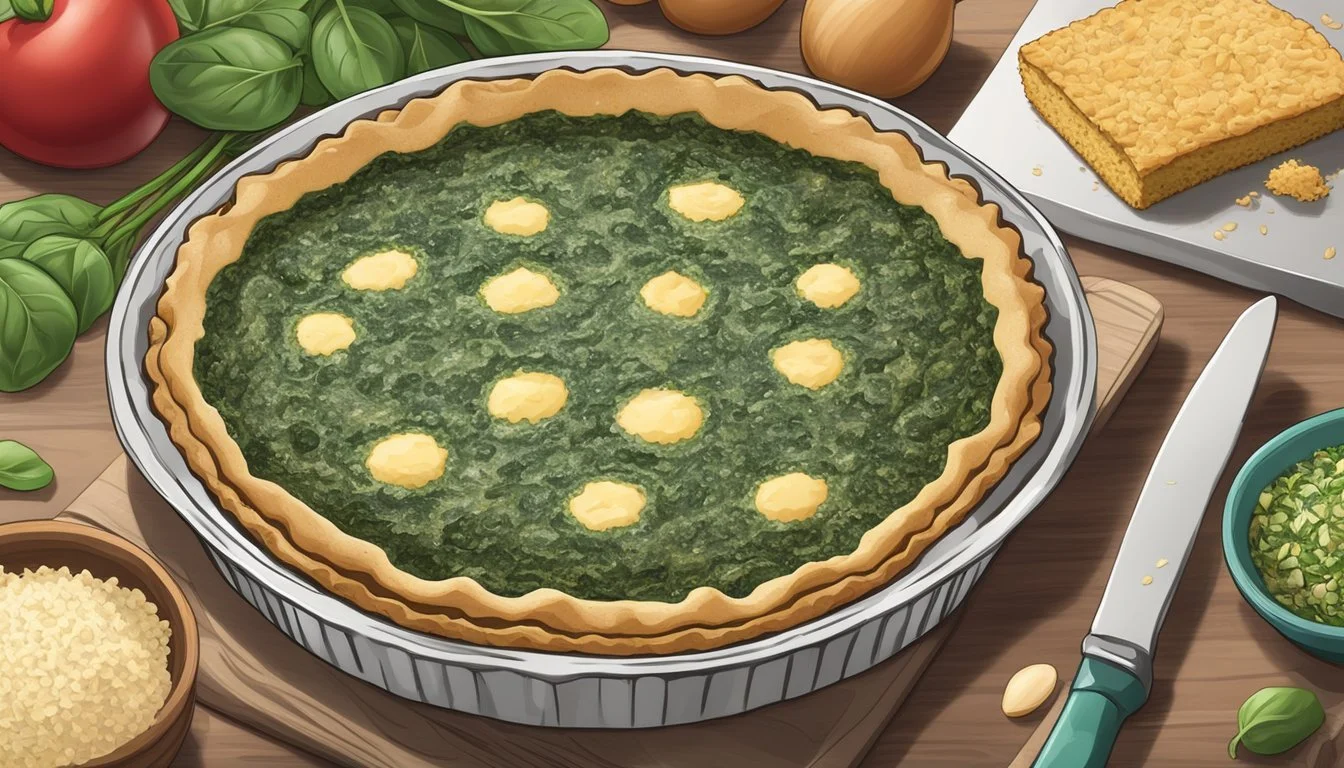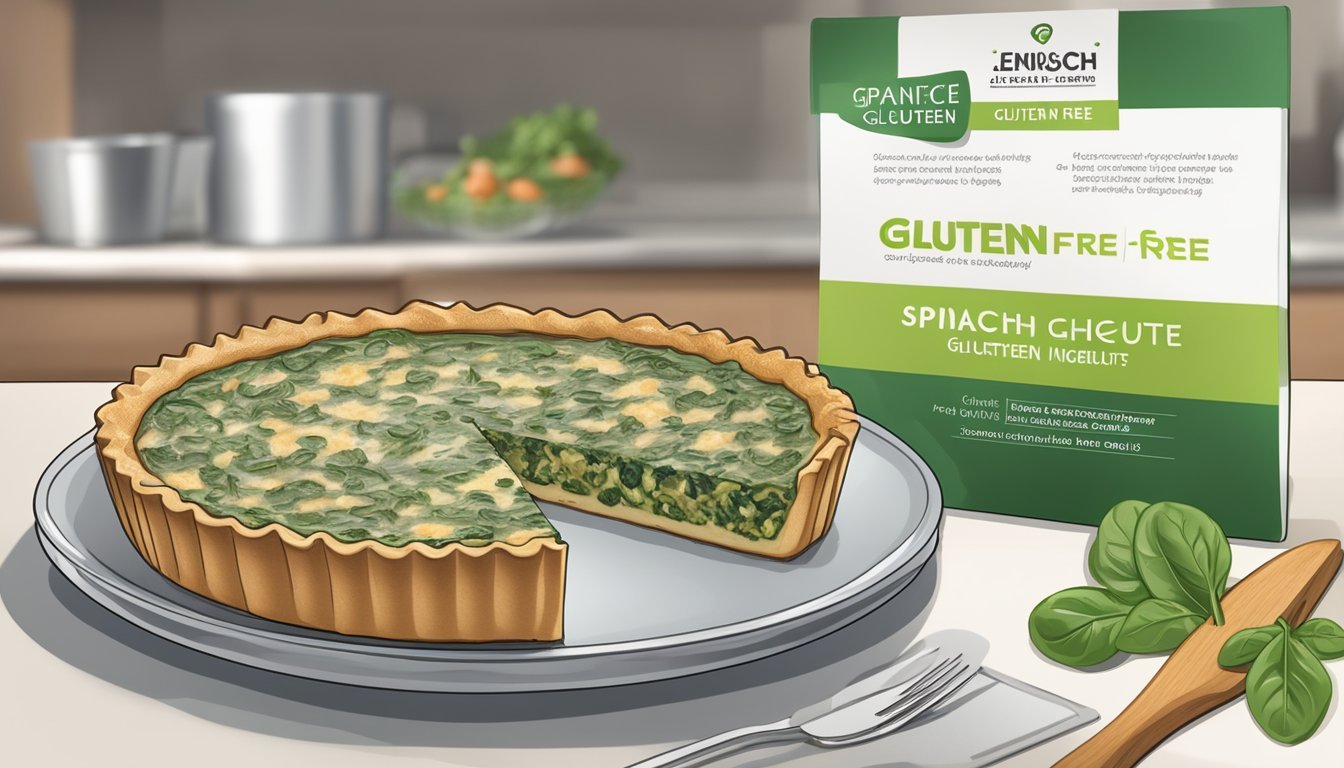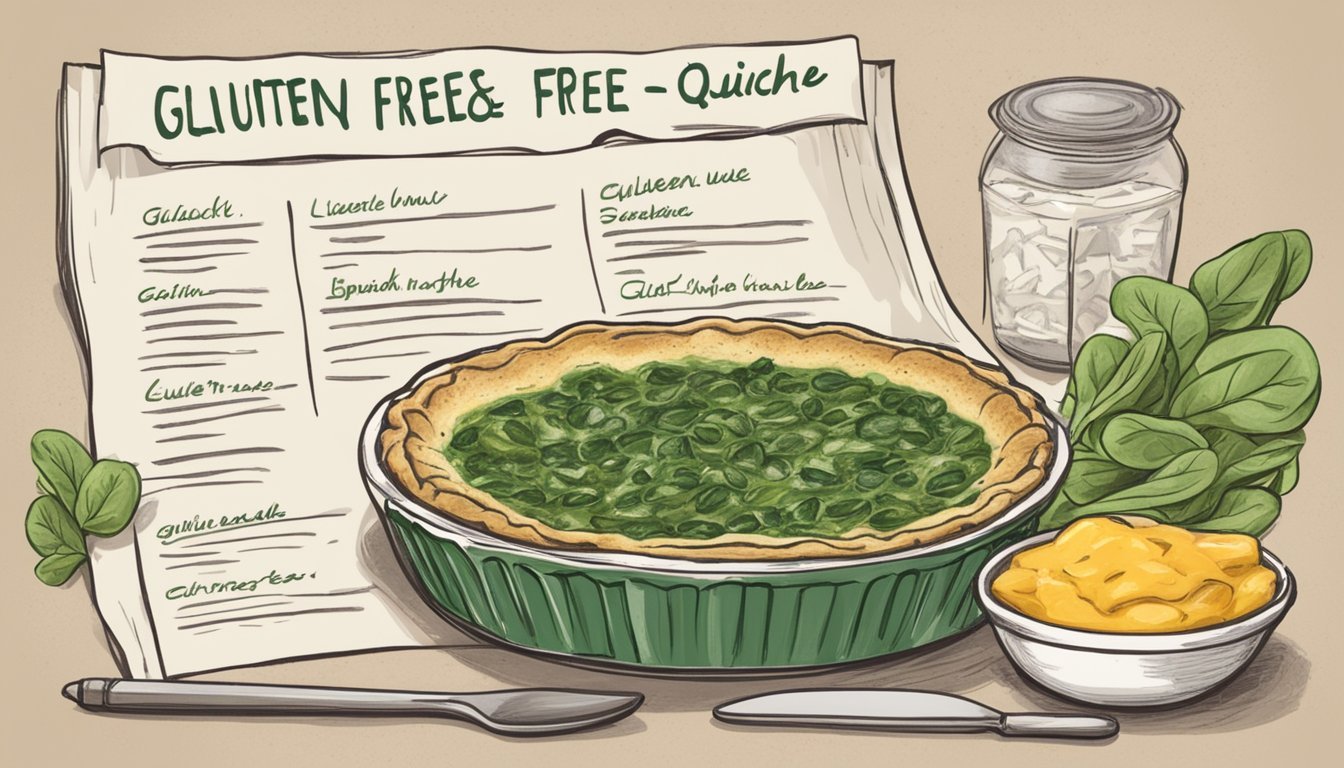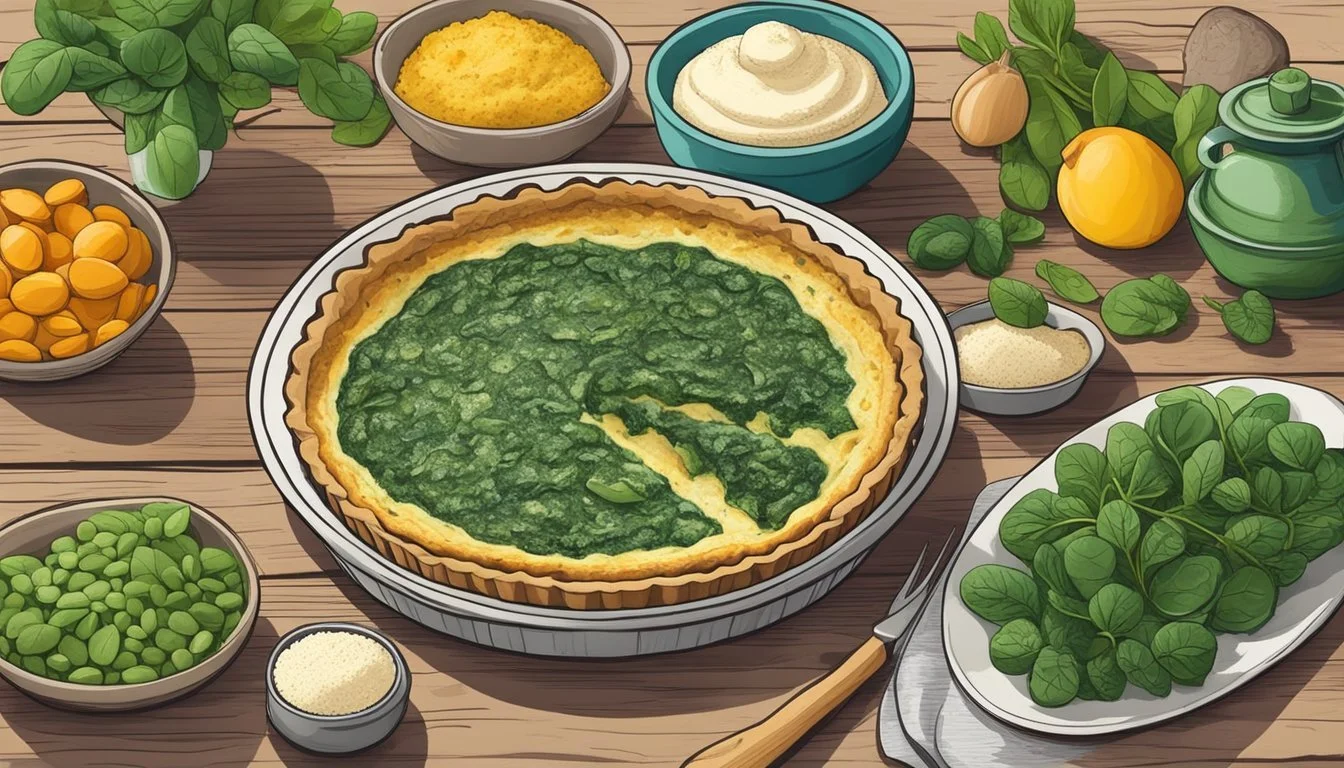Is Spinach Quiche Gluten-Free?
Decoding Ingredients for Dietary Needs
Spinach quiche is a beloved dish known for its rich flavor and versatility. At its core, the dish comprises a savory custard filling with spinach (What wine goes well with spinach?) and cheese, typically baked in a pastry crust. The gluten-free aspect of a spinach quiche typically hinges on the crust, as traditional quiche recipes include crusts made from wheat flour, which contains gluten. However, the increasing prevalence of gluten-free diets has led to the innovation of quiche recipes that either omit the crust entirely, resulting in what's known as a crustless quiche, or employ gluten-free flour blends for a safe pastry alternative.
For individuals with celiac disease, gluten sensitivity, or those who choose a gluten-free lifestyle, the concern for gluten in a spinach quiche is legitimate. Owing to dietary needs, the market and home cooks have adapted by using naturally gluten-free ingredients like eggs, fresh spinach, and cheese while avoiding all sources of gluten in thickeners, crusts, and other additives. The adaptability of the quiche allows it to be enjoyed in a gluten-free form without sacrificing its essential qualities.
The availability of gluten-free quiche options has expanded with recipes that call for a variety of gluten-free ingredients. These include gluten-free baking mixes for the crust or alternative bases such as almond flour, as well as guidance on using the correct proportions of thickeners like cornstarch or arrowroot to avoid the gluten found in conventional flour. This approach ensures that the texture and flavor of the quiche remain intact while providing a safe dining experience for those avoiding gluten.
Understanding Gluten-Free Diets
When adopting a gluten-free diet, individuals exclude gluten, a protein found in wheat, barley, and rye. This section will delve into what the diet entails and the potential benefits associated with it.
What Is Gluten-Free?
A gluten-free diet strictly avoids any foods containing gluten. Gluten is predominantly found in grains such as wheat, barley, and rye. For a product to be labeled gluten-free, it must meet strict guidelines set by food safety authorities, containing less than 20 parts per million (ppm) of gluten. Here is a breakdown of common gluten-containing and gluten-free grains:
Gluten-Containing Grains Gluten-Free Grains Wheat Rice Barley Quinoa Rye Buckwheat Triticale Corn Millet
Foods like bread, pasta, cakes, and beers made from these gluten-containing grains are off-limits unless specifically made to be gluten-free.
Benefits of a Gluten-Free Lifestyle
Individuals who choose a gluten-free lifestyle often do so for health-related reasons. The primary benefit of a gluten-free diet is for those with celiac disease, as gluten consumption can lead to severe gastrointestinal issues and interfere with the absorption of nutrients. Some people may also have gluten sensitivity or wheat allergies, in which case a gluten-free diet can help alleviate symptoms such as bloating, gas, and diarrhea.
Furthermore, a gluten-free diet may lead to improved health and well-being for some people, even in the absence of an intolerance or allergy. These individuals may report increased energy levels and an overall feeling of improved health. However, it is essential for anyone considering this diet to plan carefully to ensure they receive all necessary nutrients.
Spinach Quiche Fundamentals
Understanding the essentials of a spinach quiche is key to appreciating its savory charm and nutritional benefits. It's a dish that brings together the simplicity of eggs with the versatility of spinach in a filling that's both rich in flavor and texture.
What Makes a Quiche?
A quiche is a savory pastry comprising an egg-based custard filling combined with ingredients like cheese, meat, seafood, or vegetables, all encased within a pie crust. The absence of a crust categorizes a quiche as “crustless,” which is an appealing option for those following a gluten-free diet. For a quiche to truly be gluten-free, any crust present or the lack thereof must exclude gluten-containing grains.
Base Ingredients:
Eggs: The foundation of the custard filling.
Milk or Cream: Adds richness to the custard.
Cheese: Provides flavor and texture.
Optional Enhancements:
Meats: Such as bacon or ham for added protein.
Vegetables: Including onions, peppers, or mushrooms for extra nutrition and taste.
Seasonings: Salt, pepper, herbs, and spices tailor the flavor profile.
Role of Spinach in Quiches
Spinach, with its subtle yet distinct taste, plays a significant role in spinach quiches. It introduces both color and a nutritional boost to the quiche, contributing vitamins and minerals. Spinach's versatility allows it to blend well with a variety of additional fillings and can be used fresh or frozen.
Nutritional Contribution: High in iron, calcium, and vitamins A, C, and K.
Preparation: Fresh spinach should be wilted and drained; frozen spinach must be thoroughly defrosted and excess moisture removed.
Texture and Flavor: Provides a moisture-rich texture and a complementary earthy flavor to the creamy, custard base.
Ingredients Breakdown
Creating a gluten-free spinach quiche requires careful selection of ingredients to ensure both delicious flavor and adherence to dietary restrictions. Below is a breakdown of key components in a gluten-free spinach quiche, including vegetables, cheeses, and crust options.
Choosing the Right Vegetables
For a nutritious and flavorful quiche, spinach is the star vegetable, providing essential vitamins and minerals. It should be fresh and thoroughly washed to remove any grit. It is sautéed in olive oil until wilted before it's added to the quiche. Additionally, onions should be softened in olive oil to bring out their sweetness and combined with spinach. Mushrooms can also be included for a savory, umami element; they should be cooked until browned. It's vital that any excess moisture is removed from the vegetables to prevent a soggy quiche.
Selecting Cheeses for Flavor
Cheese adds a depth of flavor and creaminess to the quiche. A combination of cheddar, parmesan cheese, and Swiss cheese is common, offering a mix of sharp, nutty, and sweet flavors. To remain gluten-free, cheeses must not contain any gluten-containing additives. Cheddar provides a sharp tang, while Parmesan imparts a salty, umami quality. Swiss cheese adds a mild, sweet nuttiness. All cheeses should be grated and mixed evenly with the other filling ingredients to ensure uniform flavor throughout.
Crust Considerations
For a quiche to be gluten-free, the crust must be made without wheat flour. Instead, a blend of gluten-free flours, combined with butter for richness and salt for seasoning, can be used. The dough should be pressed into the pie dish and par-baked to maintain structure. Some recipes may opt for a crustless quiche, eliminating the need for flour altogether and focusing on the egg and cheese mixture to hold the quiche together. In this case, greasing the pie dish is essential to prevent sticking, and the baking temperature is carefully controlled to allow the eggs to set perfectly without a crust.
Gluten-Free Alternatives
Creating a delicious spinach quiche without gluten is completely feasible with the right choice of ingredients. The following subsections explore alternative crust options and dairy-free modifications to ensure the quiche meets specific dietary requirements.
Gluten-Free Crust Options
For individuals maintaining a gluten-free diet, the cornerstone of a gluten-free quiche is the pie crust. Traditional crusts are wheat-based, but there are several alternatives:
Pre-Made Gluten-Free Pie Crusts: Available in stores, allowing for convenience and reliability.
Homemade Crusts: Using gluten-free flours such as rice, almond, or coconut flours, bound with xanthan gum if needed.
Crustless Options: Simply omitting the crust altogether focuses the dish on the flavorful filling.
A popular homemade crust recipe includes mixing together 1 cup of almond flour with 3 tablespoons of melted butter and a pinch of salt, pressing the mixture into a pie plate and baking until set.
Dairy-Free Modifications
In addition to a gluten-free crust, some individuals require or prefer dairy-free alternatives. Here are a few options:
Non-Dairy Milk: A variety of milk substitutes such as almond, soy, or oat milk can be used in place of traditional cow's milk.
Dairy-Free Cheese: Nutritional yeast or vegan cheese products are often utilized for their cheesy flavor without containing dairy.
Egg Replacements: Although not dairy, some may seek to replace eggs; options include silken tofu or commercial egg replacers.
Using these alternatives, individuals can enjoy a flavorful, nutrient-packed spinach quiche that caters to both gluten-free and dairy-free diets without sacrificing taste or texture.
Preparation and Cooking Guide
Making a gluten-free spinach quiche involves a blend of precise preparation and specific baking techniques. Both preparation and cooking are critical to achieving the perfect quiche with a delicious taste and ideal texture.
Instructions for a Perfect Quiche
To begin the quiche, prep time typically ranges from 20 to 30 minutes, with an additional chill time in some recipes that require resting the dough. One must first prepare a gluten-free crust—either store-bought or homemade. For a homemade crust, mix gluten-free flour with butter and cold water, then form into a dough, and press it into a pie plate, followed by chilling to prevent shrinkage during baking.
Cook time is divided into two stages:
Blind baking the crust, which involves baking the crust partially before adding the filling, often requires 7-8 minutes at 400°F (205°C). This step prevents a soggy bottom. Pie weights or dry beans can be used to keep the crust's shape.
After adding the filling, which consists of eggs, cream, cheese, and spinach, the quiche needs to bake for approximately 30-40 minutes at a lower temperature of 350°F (175°C), achieving a total baking time of 37-48 minutes.
Total time, including prep, chilling, and baking, is typically around 1 hour to 1 hour and 30 minutes.
Baking Tips and Techniques
When blind baking, it's essential to keep a close eye on the crust to avoid over-browning. After this step, reducing the oven temperature is crucial to cook the quiche thoroughly without burning the crust.
A baking sheet placed underneath the pie plate can catch any drips and make it easier to transfer the quiche in and out of the oven. The quiche is done when the center is set but still slightly jiggly. Letting the quiche rest before serving allows it to firm up for neat slices.
Carefully timing each step and monitoring the oven ensures the quiche is golden brown, and the filling is cooked through but not overdone.
Nutritional Information
In the context of a gluten-free spinach quiche, the nutritional content can vary based on the specific recipe and portion size. The following subsections will provide detailed information on the calories, macronutrients, and the vitamins and minerals that are typically found in such a dish.
Calories and Macronutrients
Calories: A standard serving of gluten-free spinach quiche can range between 200 to 300 calories. The precise calories can be influenced by the use of lower-fat ingredients or the addition of calorie-dense items like cheese.
Fat: A slice may have about 15 to 25 grams of fat, depending on the use of ingredients like cheese and eggs. Recipes calling for skim milk or egg whites will have less fat.
Protein: Spinach quiche is often a good protein source, providing approximately 10 to 15 grams per serving from eggs and dairy products.
Carbohydrates: The absence of a traditional crust means fewer carbs, with total amounts typically under 10 grams.
Fiber: Spinach contributes to the fiber content, which can be around 1 to 2 grams per serving.
Vitamins and Mineral Content
Iron: Spinach is a known source of iron, essential for blood health. A quiche serving might offer about 15% of the daily recommended intake.
Calcium: Cheese and milk in the quiche contribute to calcium, beneficial for bone health. One serving could provide around 20% of the daily value.
Vitamin C: While not traditionally high in Vitamin C, some spinach quiche recipes may add tomatoes or bell peppers, increasing the content.
Vitamin A: Spinach is rich in Vitamin A, which supports vision and immune function. A serving typically contains a substantial amount of the recommended daily intake.
Water: Dishes that contain significant amounts of vegetables, like spinach, naturally have more water content, contributing to hydration.
Customization and Variations
When creating a gluten-free spinach quiche, the flexibility of ingredients allows for a rich diversity of flavors and textures. Catering to different dietary requirements and personal tastes can be easily achieved through the selection of specific vegetables, cheeses, and optional meats.
Vegetable and Cheese Varieties
Vegetables: For those looking to experiment beyond spinach, a variety of other vegetables can be incorporated into the quiche. Common choices include:
Broccoli: A nutritious addition that pairs well with a variety of cheeses.
Kale: Its bold flavor complements milder cheeses and adds a vibrant green to the dish.
Tomatoes: When used, they should be seeded to reduce excess moisture.
Bell Peppers: These can be diced or sliced and come in a range of colors, each adding sweetness and crunch.
Cheeses: The choice of cheese can dramatically change the flavor profile of the quiche.
Parmesan: Adds a distinct, salty flavor and is often used as a topping for an extra layer of texture.
Swiss: Melts well and provides a mild, nutty flavor.
Cheddar: Offers a sharper taste for those who prefer a bolder quiche.
Feta: Gives a creamy and tangy twist, pairing especially well with spinach and tomatoes.
Meat and Meatless Options
Meat Options: Incorporating meat into a gluten-free quiche can enhance the dish with extra protein and flavor.
Bacon: A popular choice for its smoky taste, it should be cooked and crumbled before adding to the mix.
Ham: Diced ham can be used for a more subtle, smoky flavor.
Meatless Options: Vegetarians, or those simply opting for a meat-free quiche, can focus on the vegetables and cheeses for a fulfilling dish. The inclusion of various vegetables like tomatoes and bell peppers, alongside a mix of cheeses, ensures a rich and satisfying flavor without the need for meat.
Serving and Storage Tips
Spinach Quiche can be a delightful dish for any meal, whether it's brunch (What wine goes well with brunch?), breakfast, lunch, or dinner. Knowing how to properly serve and store this dish ensures that its quality is maintained and it remains enjoyable.
Best Practices for Serving Quiche
When serving Spinach Quiche, it's important that it is served at the optimal temperature. For the best experience:
Serve the quiche warm, typically after letting it cool for about 10 to 15 minutes after removing it from the oven. This waiting period allows the quiche to set and flavors to meld.
If serving for brunch or lunch, pair the quiche with a light salad or seasonal vegetables to create a balanced meal.
For breakfast, consider smaller portions alongside fruit or breakfast potatoes.
Reheating leftovers should be done gently to avoid making the crust soggy. Reheat in the oven at a moderate temperature until just warmed through.
Storing and Freezing Quiche
Storing Spinach Quiche for later consumption requires attention to detail to maintain its texture and flavor.
Cool completely before storing to prevent condensation from making the crust soggy.
For short-term storage, cover the quiche with plastic wrap or aluminum foil and refrigerate for up to 3 days.
Use a freezer-safe container to freeze individual slices or the entire quiche. This helps maintain the quality and prevents freezer burn.
Label the container with the date frozen and consume within 1 to 3 months for best quality.
To thaw, place the quiche in the refrigerator overnight. Avoid microwaving to defrost, as it can unevenly heat and compromise the texture of your dish.
Gluten-Free Quiche Recipe
Creating a gluten-free spinach quiche involves a careful selection of ingredients to ensure the final product is suitable for those with gluten sensitivities. A gluten-free crust is essential, and a mixture of eggs, spinach, and dairy forms the basis of the filling. The recipe detailed below outlines the process, from preparation to baking.
Step-by-Step Recipe
Ingredients:
4 large eggs, beaten
1 cup heavy cream or whole milk
2 cups fresh spinach, chopped
1 cup grated cheese (e.g., cheddar or Gruyère)
1/4 cup Parmesan cheese, grated
1 teaspoon salt
1/4 teaspoon ground nutmeg
1 prebaked gluten-free pie crust
Preparation:
Preheat your oven to 350°F (175°C).
In a large mixing bowl, whisk together the eggs, cream, salt, and nutmeg until well combined.
Add the grated cheese, reserving the Parmesan, and the chopped spinach, ensuring the spinach is evenly dispersed throughout the egg mixture.
Assembling the Quiche:
First, evenly sprinkle half of the reserved Parmesan cheese into the bottom of the gluten-free crust shell.
Pour the egg and spinach mixture over the cheese layer in the pie crust.
Top with the remaining Parmesan cheese.
Baking:
Place the filled pie pan into the preheated oven.
Bake for 30-35 minutes, or until the quiche is set and the top starts to turn golden.
A knife inserted into the center should come out clean when the custard is cooked through.
Total Time:
Prep time: 20 minutes
Cook time: 30-35 minutes
Total time: Approximately 55 minutes
Servings and Presentation
Serving Size: This spinach quiche recipe makes approximately 6-8 servings, ideal for a family meal or a brunch gathering.
Presentation: Upon removing the quiche from the oven, let it rest for a few minutes. Slice it into wedges and serve warm. Optionally, it can be garnished with fresh herbs or a light salad on the side for an elegant touch.
Frequently Asked Questions
In this section, readers will find clear and accurate answers to common queries regarding gluten-free spinach quiche, ensuring they can enjoy this savory dish with confidence.
Addressing Common Concerns
Is all spinach quiche gluten-free?
No, traditional quiche often includes a crust made with flour, which contains gluten. However, one can make crustless quiche or use gluten-free flour to cater to a gluten-free diet.
Can I use frozen spinach in my gluten-free quiche?
Yes, frozen spinach can be used, but it's crucial to thoroughly thaw and drain it to remove excess moisture which can affect the quiche's texture.
How can I ensure my homemade spinach quiche is gluten-free?
Carefully select ingredients that do not contain gluten. For the crust, either go crustless or opt for gluten-free flour alternatives.
Tips for Perfecting Quiche
For a golden, crustless quiche
Ensure the oven is preheated to the right temperature to achieve that desirable golden top. A crustless quiche also typically requires less baking time.
Homemade quiche that's easy to make
Keep the ingredients simple. Whisk together eggs and a dairy base, fold in wilted spinach, and pour into a pie plate for an easy to make dish.
Getting wilted spinach right
Sauté fresh spinach until it's wilted for an enhanced flavor. Remember to drain any excess liquid to prevent a soggy quiche.
Community and Engagement
In the realm of gluten-free baking, spinach quiche has carved out its niche. Sharing this cornerstone dish and obtaining feedback are pivotal for growth and enjoyment within gluten-free communities.
Share Your Quiche Creations
Individuals passionate about gluten-free cooking often take to Instagram and Pinterest to exhibit their culinary achievements. Posting images or videos of a homemade gluten-free spinach quiche can inspire others and showcase the variety available within a gluten-free diet. Utilizing hashtags like #GlutenFreeCooking and #SpinachQuiche, they can reach a wider audience and become part of a larger conversation.
Platforms to share:
Instagram: A visual-centric platform ideal for sharing high-quality images of your quiche.
Pinterest: Perfect for pinning recipes and ideas that others can discover and try.
Getting Feedback and Reviews
Community engagement does not end at sharing; it extends to learning from others. Cooks can invite feedback through comments on social platforms or by joining specialized Facebook groups dedicated to gluten-free living. Reviews help individuals refine their recipes and cooking techniques. They can use structured formats to prompt specific feedback:
Feedback Questions
How was the texture?
Was the flavor well-balanced?
Any suggestions for improvement?
By receiving critiques and encouragement, they grow as cooks and contributors to the gluten-free community.
Final Thoughts
In assessing whether spinach quiche is gluten-free, one must carefully examine the ingredients. Traditional quiche recipes often include a flour-based crust, which contains gluten. However, crustless versions are inherently gluten-free in the absence of crust, provided that all other ingredients are also free of gluten. For those with a gluten intolerance or celiac disease, avoiding gluten is crucial for health.
To ensure a gluten-free spinach quiche, one may consider:
Substituting Flour: When a crust is desired, use gluten-free flour blends instead of wheat flour.
Pre-Made Crusts: Select pre-made gluten-free crusts available in the market.
Ingredient Check: Verify that each ingredient, such as cheese and cream, is gluten-free, as some additives may contain gluten.
Remember, even in home-cooked meals, cross-contamination can occur if gluten-containing products are processed in the same area. Therefore, strict kitchen protocols are necessary for preparing a truly gluten-free dish.
Conclusively, spinach quiche can fit into a gluten-free diet when due diligence is applied in the selection of ingredients and the preparation process. One must always be vigilant, reading labels and sticking to trusted gluten-free recipes to enjoy this classic dish without the worry of gluten exposure.
Appendix
This section provides additional resources and acknowledgments related to creating a gluten-free spinach quiche, ensuring that readers have access to credible and specific sources for ingredients and can recognize the contributions of those who have made this guidance possible.
Resource List for Gluten-Free Ingredients
The following table outlines key ingredients for a gluten-free spinach quiche, along with recommended sources to ensure the absence of gluten:
Ingredient Recommended Brand/Source Gluten-Free Flour Bob's Red Mill, King Arthur Eggs Any local or organic farm Dairy (Milk/Cream) Organic Valley, lactose-free options Spinach Fresh from produce section or frozen options marked gluten-free Cheese Whole blocks labeled as gluten-free Seasonings Certified gluten-free labels, e.g., McCormick
Acknowledgments
The development of gluten-free recipes is supported by an array of expert chefs, food bloggers, and nutritionists who share their knowledge. The authors extend gratitude to creators of the above-listed recipes for their invaluable insights into creating delectable gluten-free dishes. Special thanks are also due to gluten-free communities for their continuous feedback and shared experiences that enhance the quality of gluten-free cuisine.









